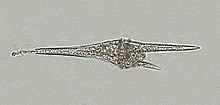Dinoflagellate
| Dinoflagellata Temporal range: 250–0 Ma Triassic or earlier–Present |
|
|---|---|
 |
|
| Ceratium furca | |
| Scientific classification | |
| Domain: | Eukaryota |
| (unranked): | SAR |
| (unranked): | Alveolata |
| Phylum: |
Dinoflagellata Bütschli 1885 [1880-1889] sensu Gomez 2012 |
| Classes | |
| Synonyms | |
|
|
The dinoflagellates (Greek δῖνος dinos "whirling" and Latin flagellum "whip, scourge") are a large group of flagellate eukaryotes that constitute the phylum Dinoflagellata. Most are marine plankton, but they are common in freshwater habitats, as well. Their populations are distributed depending on temperature, salinity, or depth. Many dinoflagellates are known to be photosynthetic, but a large fraction of these are in fact mixotrophic, combining photosynthesis with ingestion of prey (phagotrophy). In terms of number of species, dinoflagellates form one of the largest groups of marine eukaryotes, although this group is substantially smaller than the diatoms. Some species are endosymbionts of marine animals and play an important part in the biology of coral reefs. Other dinoflagellates are unpigmented predators on other protozoa, and a few forms are parasitic (see for example Oodinium, Pfiesteria). Some dinoflagellates produce resting stages, called dinoflagellate cysts or dinocysts, as part of their lifecycles.
Dinoflagellates are considered to be protists, with their own division, Dinoflagellata.
About 1,555 species of free-living marine dinoflagellates are currently described. Another estimate suggests about 2,000 living species, of which more than 1,700 are marine (free-living, as well as benthic) and about 220 are from fresh water. The latest estimates suggest a total of 2,294 living dinoflagellate species, which includes marine, freshwater and parasitic dinoflagellates.
...
Wikipedia
